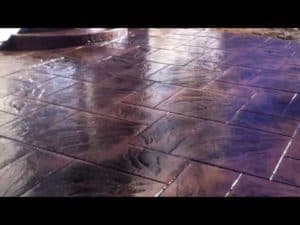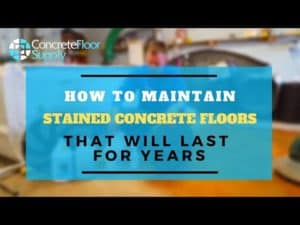781306 views 7617 likes 163 dislikes
Channel: DIY PETE
How to Acid Stain Concrete. In this video DIY PETE will walk you through the process of staining a concrete patio. This is a great weekend project that is simple and affordable. Your boring grey concrete will transfrom into a beautiful area of your home.
For more info, project photos, and downloadable plans check out:
http://www.diypete.com/howtoacidstain
Degrease and Remove Stains / Paint
Use a power washer to do an initial cleaning of the concrete. Once wet, you’ll be able to see if there are problem areas of oil, paint, or grease. You will want to remove any paint or oil because acid stain will not “TAKE” or “REACT” with the concrete in those areas.
Paint is somewhat tough to remove. Try using a paint remover in combination with a razor blade or wire brush first. If this does not work, try using an orbital sander. The concrete will look slightly different where you’ve used these tools, but will look much better than it would if there were paint or grease areas.
Tape and Mask
After cleaning and letting the area dry up, you’ll want to tape and mask siding, trim, doors, and any other surfaces you don’t want to get stain on.
Prepare Acid Stain
Pour acid stain into a pump sprayer. For this patio, I used Dark Walnut by Scofield Chemstain. This gave the concrete a natural brown color. You can use a highlight color if you’d like to mix another color in a separate sprayer. This is not necessary. I highlighted mine with Quikrete Coffee Acid stain.
I would recommend diluting the acid stain according to the manufacturers instructions. I mixed mine about 1 part stain to 1 part water. Remember you can always add additional coats to darken the stain. You cannot lighten a stain, which is why I prefer diluting the stain and doing multiple coats to give me a little more control over how dark the stain will be.
Wet the concrete
Before applying acid stain, I’d recommend misting the entire surface with water. You don’t want too much that it puddles, but the entire surface should be saturated. This helps the stain go on more evenly and also makes the staining process a little more forgiving. For instance, if you accidentally get a drop of acid stain on dry concrete it is going to leave a more noticeable spot. If the concrete is wet, it will help it blend a bit more. I used an additional pump sprayer for this process.
Apply Acid Stain to Concrete
Use a pump sprayer to apply the acid stain. Apply enough to saturate the concrete but not to puddle. Apply in a zig-zag type motion to give it variation and a random look as opposed to applying in straight lines. (See the video for a better description). Do not walk on the acid stain once it is applied or you’ll have footprints in the final product. If you’d like a more uniform finish with less variation, a second person can use a shop broom to help brush the stain into the concrete immediately after you’ve sprayed the stain.
Applying the second coat of stain to darken the concrete up a little more. Allow the stain to dry for a full 8 hours or overnight before neutralizing the stain. This will ensure the stain penetrates into the surface completely.
Neutralize Acid Stain
Neutralize the stain using Ammonia and water once the stain has dried for at least 8 hours. I’d recommend using 2 cups of ammonia per 5 gallon bucket of water. Once neutralized, the acid will no longer react.
Apply Sealer
Seal the concrete. I like to use solvent based sealers for concrete patios, but you are welcome to use water-based if you’d prefer. I’ve found H&C concrete sealer to work well for outdoor applications. The Clear Gloss version gives the stain a rich color / wet look and is super durable. I’ve also had good luck using SuperSeal 2000 which is available on Amazon. Make sure you don’t seal when the temperature is above the recommended sealing temperature set by the manufacturer. Bubbling of the sealer is one problem that can occur if sealed when the concrete is too hot. If you are sealing the concrete with a roller and bubbles are forming, you can get rid of bubbles by running a brush over the problem areas.
—-
Looking for more DIY videos? Be sure to check out our channel and subscribe for updates! We post a weekly tutorial every Thursday.
Looking for woodworking, concrete working, and other DIY projects plans to follow? You can download plans for free at http://gumroad.com/DIYPETE
Facebook: http://facebook.com/DiyProjectsWithPete
Instagram: http://instagram.com/diypete
Pete Sveen
1627 W Main Street Suite 182
Bozeman, Montana 59715
Video length: 9:23
Category: Howto & Style
408 comments
* This video was originally published here
Find a local concrete contractor in your area to help you with your concrete flooring needs by searching here on Concrete Floor Pros.
#concretefloorpros



